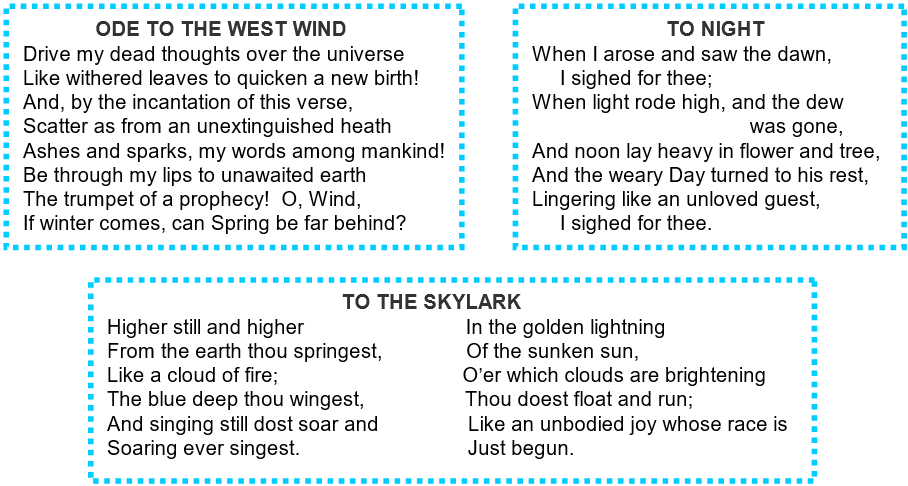


xxxxxThe
poet Percy Bysshe Shelley was one of the leading figures in the
English Romantic movement. Deeply devoted to the cause of political
and social freedom, many of his works -
PERCY BYSSHE SHELLEY 1792 -
(G3b, G3c, G4)
Acknowledgements
Shelley: by the
English painter Alfred Clint (1807-
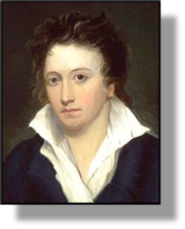 xxxxxThe English poet Percy Bysshe Shelley was one of the
leading and most influential figures in the Romantic Movement. It is
not difficult to see why. Rebellious by nature, deeply devoted to
the cause of political freedom, and with a great love of nature, he
possessed, in addition, the intellect and the poetic skill to convey
his thoughts in majestic and memorable verse. There was, as the
English essayist William Hazlitt later put it, “a fire in his eye
and a fever in his blood” when it came to social and political
injustice.
xxxxxThe English poet Percy Bysshe Shelley was one of the
leading and most influential figures in the Romantic Movement. It is
not difficult to see why. Rebellious by nature, deeply devoted to
the cause of political freedom, and with a great love of nature, he
possessed, in addition, the intellect and the poetic skill to convey
his thoughts in majestic and memorable verse. There was, as the
English essayist William Hazlitt later put it, “a fire in his eye
and a fever in his blood” when it came to social and political
injustice.
xxxxxHe
was born at Field Place, near Horsham in Sussex. The member of a
wealthy family, he attended Syon House Academy and Eton public
school, where, sensitive by nature and somewhat feminine in
appearance and manner, he was mocked and bullied by “tyrants and
foes”. However, he was not without spirit and will power, and when
he went up to Oxford in 1810 he was quickly at odds with authority.
In 1811, being opposed to religion, he and a student friend wrote a
two-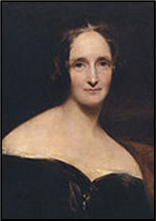 first
major work, Queen Mab. Largely the result
of correspondence he had had with the social philosopher William
Godwin, this long poem took society to task, calling for social and
political reform, and attacking in particular the institutions of
monarchy, church and marriage. The
first
major work, Queen Mab. Largely the result
of correspondence he had had with the social philosopher William
Godwin, this long poem took society to task, calling for social and
political reform, and attacking in particular the institutions of
monarchy, church and marriage. The
xxxxxThey lived for a short time near Windsor, where Shelley worked alongside his friend Thomas Love Peacock, but in May 1816 he and Mary travelled to Geneva to meet up with Byron. They were accompanied by Mary’s step sister Claire (formerly Jane) Clairmont, who was having an affair with Byron at that time. It was there that Shelley wrote his poems Hymn to Intellectual Beauty and Mont Blanc, and Mary began work on her famous novel Frankenstein. They returned to England later that year and it was soon after this that they learnt that, by all accounts, his wife, Harriet, had drowned herself in the Serpentine in London’s Hyde Park. This tragic event enabled Shelley and Mary to be married, but his two children, Ianthe and Charles, were put into care on the grounds that Shelley, as an atheist, was not fit to raise them. Having regained Godwin’s approval by their marriage, in March 1817 they settled near Marlow, close to where Peacock lived, and joined a circle of friends which included John Keats and Leigh Hunt. Here they wrote up an account of their travels on the continent, and Shelley returned to his revolutionary theme, pressing the need for protest in pamphlets signed under the nom de plume “The Hermit of Marlow”. Soon, however, they were again short of money and were obliged to make for Italy, that “paradise of exiles”, where living was much cheaper.
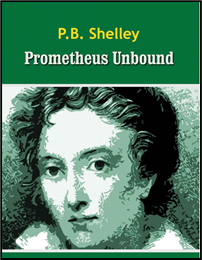
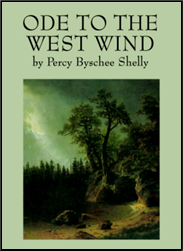 xxxxxThey left England for the last time early in 1818. They
met up with Byron at Venice and then journeyed about Italy, making
short stays at Naples, Rome, Leghorn, Florence and Pisa. At Pisa
they were joined by Byron, and in the early summer of 1822 they all
moved to Leghorn (Livorno) where Byron hired a villa on the bay of
Lerici, close to Shelley’s house. It was during this period (1818-
xxxxxThey left England for the last time early in 1818. They
met up with Byron at Venice and then journeyed about Italy, making
short stays at Naples, Rome, Leghorn, Florence and Pisa. At Pisa
they were joined by Byron, and in the early summer of 1822 they all
moved to Leghorn (Livorno) where Byron hired a villa on the bay of
Lerici, close to Shelley’s house. It was during this period (1818-
xxxxxBut during these years his battle against political oppression continued unabated. Indeed, three of his works, The Masque of Anarchy, a call to arms following the Peterloo Massacre of August 1819; his Peter Bell the Third, a satire on Wordsworth, linked to a scathing attack upon corruption within British society; and his Philosophical Review of Reform, urging a movement for modest change, were considered too radical for publication. The first two did not appear until the 1830s, and the third was not published until 1920! In addition, in 1818 he published The Revolt of Islam, a revised version of his romance epic Laon and Cynthia (suppressed the previous year because it had included the ruthless crushing of a peaceful uprising), his Ode to Liberty, and his verse drama Hellas, in which he joyfully anticipates the success of the Greeks in their fight for freedom.
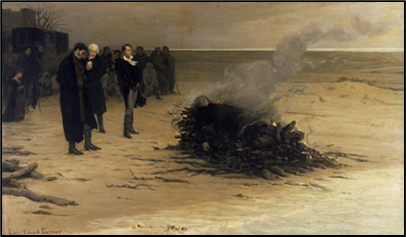 xxxxxIn 1821, the year before his own death, Shelley wrote
his Adonais, an elegy full of grace and
splendour on the death of John Keats (who had died in Rome earlier
that year). And he also began writing his Defence
of Poetry, a prose work in which he argued that poets were
“the unacknowledged legislators of the world”, creating the human
values that fashion the social order. In 1822 the poet Leigh Hunt
arrived at Leghorn, invited to assist Shelley and Byron in the
editing of The Liberal, a new radical
journal they were putting together to counter
the conservative periodicals such as The
Quarterly Review and Blackwood’s
Magazine. Shelley travelled by his yacht , the Ariel,
to see him and, once their work had been completed, he and his
friend Edward Williams started their return journey, making for San
Terenzo on the Bay of Lerici. They never made it. It seems that the
small open boat was overturned by a sudden squall and both men were drowned. Their bodies were washed
ashore ten days later near the town of Viareggio and cremated on the
beach (as required by the laws of Tuscany at that time).
xxxxxIn 1821, the year before his own death, Shelley wrote
his Adonais, an elegy full of grace and
splendour on the death of John Keats (who had died in Rome earlier
that year). And he also began writing his Defence
of Poetry, a prose work in which he argued that poets were
“the unacknowledged legislators of the world”, creating the human
values that fashion the social order. In 1822 the poet Leigh Hunt
arrived at Leghorn, invited to assist Shelley and Byron in the
editing of The Liberal, a new radical
journal they were putting together to counter
the conservative periodicals such as The
Quarterly Review and Blackwood’s
Magazine. Shelley travelled by his yacht , the Ariel,
to see him and, once their work had been completed, he and his
friend Edward Williams started their return journey, making for San
Terenzo on the Bay of Lerici. They never made it. It seems that the
small open boat was overturned by a sudden squall and both men were drowned. Their bodies were washed
ashore ten days later near the town of Viareggio and cremated on the
beach (as required by the laws of Tuscany at that time).
xxxxxThexpainting
above by the French artist Louis Édouard
Fournier (1857-
xxxxxShelley’s
ashes were taken to the Protestant cemetery in Rome and buried
near to Keats’ grave. Later,xin 1894, a
bust of Shelley, sculptured by the Italian Urbano
Lucchesi (1844-

Nothing of him that doth fade
But doth suffer a sea-
Into something rich and strange.
xxxxxIt was a
sad but, in some ways, a fitting ending to the life of so romantic
a figure. He was just a few days short of his thirtieth birthday.
It must be said, that his poems were never popular in his short
lifetime -
xxxxxIncidentally, during their last stay in Italy the Shelleys lost both of their young children. Little Clara, born in 1817 was taken ill and died while they were in Venice, and the following year their son William, born in 1816, died from malaria while they were living in Rome. Towards the end of 1819 a third child was born, Percy Florence Shelley, Mary’s only surviving child. ……
xxxxx……
In February 2005 letters from Shelley to Ralph Wedgwood, a close
relative of the potter Josiah Wedgwood, were found in a semi-
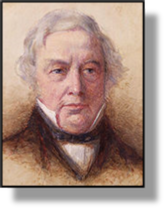 xxxxx…… The English novelist and
poet Thomas Love Peacock
(1785-
xxxxx…… The English novelist and
poet Thomas Love Peacock
(1785-
xxxxxShort extracts from five of Shelley’s poems are given below:
Including:
Mary Wollstonecraft
Shelley and John Polidori

G3c-
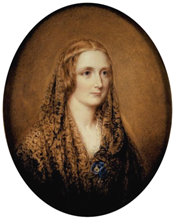 xxxxxShelley’s second
wife, Mary Wollstonecraft Shelley (1797-
xxxxxShelley’s second
wife, Mary Wollstonecraft Shelley (1797-

xxxxxHer writing skill was
first put to the test one evening in July 1816 when she, Shelley and
her step-
xxxxxFollowing Shelley’s tragic
death in July 1822, she returned to England with her only surviving
child, Percy, and busied herself with her husband’s papers. She
published his Posthumous Poems in 1824,
and edited his poetical and prose works. The journal she kept,
together with her own letters, also helped to throw a great deal of
light upon her husband’s character and remarkable talent. In
addition, she also continued her own career as a writer. Other
novels included Valperga in 1823 and The Last Man in 1826 -
xxxxxIncidentally,
and needless to say, the Gothic horror story Frankenstein,
regarded today as the origin of modern science fiction, has inspired
a number of such tales and their film counter-
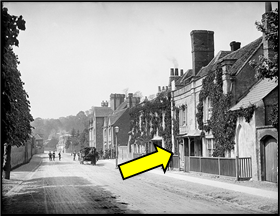 xxxxx…… She wrote the story while
she and Shelley were living in a cottage in West Street in the town
of Marlow in Buckinghamshire. The house is still there, marked by a
plaque. ......
xxxxx…… She wrote the story while
she and Shelley were living in a cottage in West Street in the town
of Marlow in Buckinghamshire. The house is still there, marked by a
plaque. ......
xxxxx…… But
Frankenstein was not the only horror
figure to be created from that evening get-
XXXXXXXX
 xxxxx…… The year 1816 has gone
down in history as “The Year without summer”. It was so cold and wet
that crops failed to grow and there was a widespread shortage of
food. It was later established -
xxxxx…… The year 1816 has gone
down in history as “The Year without summer”. It was so cold and wet
that crops failed to grow and there was a widespread shortage of
food. It was later established -
xxxxxMary Wollstonecraft
Shelley (1797-

